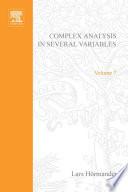
An Introduction to Complex Analysis in Several Variables
Autor: L. Hormander
Número de Páginas: 227An Introduction to Complex Analysis in Several Variables

An Introduction to Complex Analysis in Several Variables
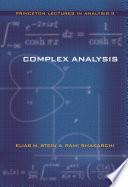
With this second volume, we enter the intriguing world of complex analysis. From the first theorems on, the elegance and sweep of the results is evident. The starting point is the simple idea of extending a function initially given for real values of the argument to one that is defined when the argument is complex. From there, one proceeds to the main properties of holomorphic functions, whose proofs are generally short and quite illuminating: the Cauchy theorems, residues, analytic continuation, the argument principle. With this background, the reader is ready to learn a wealth of additional material connecting the subject with other areas of mathematics: the Fourier transform treated by contour integration, the zeta function and the prime number theorem, and an introduction to elliptic functions culminating in their application to combinatorics and number theory. Thoroughly developing a subject with many ramifications, while striking a careful balance between conceptual insights and the technical underpinnings of rigorous analysis, Complex Analysis will be welcomed by students of mathematics, physics, engineering and other sciences. The Princeton Lectures in Analysis represents...
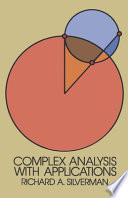
The basics of what every scientist and engineer should know, from complex numbers, limits in the complex plane, and complex functions to Cauchy's theory, power series, and applications of residues. 1974 edition.
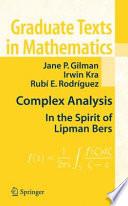
Organizing the basic material of complex analysis in a unique manner, the authors of this versatile book aim is to present a precise and concise treatment of those parts of complex analysis that should be familiar to every research mathematician.
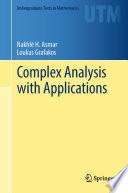
This textbook is intended for a one semester course in complex analysis for upper level undergraduates in mathematics. Applications, primary motivations for this text, are presented hand-in-hand with theory enabling this text to serve well in courses for students in engineering or applied sciences. The overall aim in designing this text is to accommodate students of different mathematical backgrounds and to achieve a balance between presentations of rigorous mathematical proofs and applications. The text is adapted to enable maximum flexibility to instructors and to students who may also choose to progress through the material outside of coursework. Detailed examples may be covered in one course, giving the instructor the option to choose those that are best suited for discussion. Examples showcase a variety of problems with completely worked out solutions, assisting students in working through the exercises. The numerous exercises vary in difficulty from simple applications of formulas to more advanced project-type problems. Detailed hints accompany the more challenging problems. Multi-part exercises may be assigned to individual students, to groups as projects, or serve as...
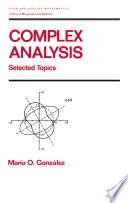
A selection of some important topics in complex analysis, intended as a sequel to the author's Classical complex analysis (see preceding entry). The five chapters are devoted to analytic continuation; conformal mappings, univalent functions, and nonconformal mappings; entire function; meromorphic fu

This carefully written textbook is an introduction to the beautiful concepts and results of complex analysis. It is intended for international bachelor and master programmes in Germany and throughout Europe; in the Anglo-American system of university education the content corresponds to a beginning graduate course. The book presents the fundamental results and methods of complex analysis and applies them to a study of elementary and non-elementary functions (elliptic functions, Gamma- and Zeta function including a proof of the prime number theorem ...) and – a new feature in this context! – to exhibiting basic facts in the theory of several complex variables. Part of the book is a translation of the authors’ German text “Einführung in die komplexe Analysis”; some material was added from the by now almost “classical” text “Funktionentheorie” written by the authors, and a few paragraphs were newly written for special use in a master’s programme.
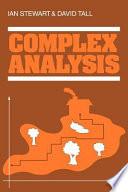
A textbook for students of pure mathematics.
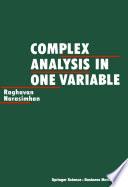
This book is based on a first-year graduate course I gave three times at the University of Chicago. As it was addressed to graduate students who intended to specialize in mathematics, I tried to put the classical theory of functions of a complex variable in context, presenting proofs and points of view which relate the subject to other branches of mathematics. Complex analysis in one variable is ideally suited to this attempt. Of course, the branches of mathema tics one chooses, and the connections one makes, must depend on personal taste and knowledge. My own leaning towards several complex variables will be apparent, especially in the notes at the end of the different chapters. The first three chapters deal largely with classical material which is avai lable in the many books on the subject. I have tried to present this material as efficiently as I could, and, even here, to show the relationship with other branches of mathematics. Chapter 4 contains a proof of Picard's theorem; the method of proof I have chosen has far-reaching generalizations in several complex variables and in differential geometry. The next two chapters deal with the Runge approximation theorem and its many...
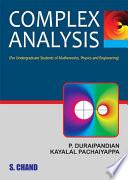
Complex Number System 17 2. Complex Plane 826 3. Sets Of Complex Points 2732 4. Analytic Functions 3360 5. Sequences And Series 6170 6. Power Series And Elementary Functions 71101 7. Elementary And Conformal Mappings 102137 8. Complex Integration 138188 9. TaylorS And LaurentS Series 189233 10. Residues 234278 11. Meromorphic Functions 279288

Designed for the undergraduate student with a calculus background but no prior experience with complex analysis, this text discusses the theory of the most relevant mathematical topics in a student-friendly manner. With a clear and straightforward writing style, concepts are introduced through numerous examples, illustrations, and applications. Each section of the text contains an extensive exercise set containing a range of computational, conceptual, and geometric problems. In the text and exercises, students are guided and supported through numerous proofs providing them with a higher level of mathematical insight and maturity. Each chapter contains a separate section devoted exclusively to the applications of complex analysis to science and engineering, providing students with the opportunity to develop a practical and clear understanding of complex analysis. The Mathematica syntax from the second edition has been updated to coincide with version 8 of the software. --
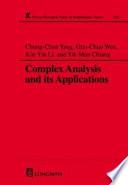
This volume presents a collection of contributions to an international conference on complex analysis and its applications held at the newly founded Hong Kong University of Science and Technology in January 1993. The aim of the conference was to advance the theoretical aspects of complex analysis and to explore the application of its techniques to physical and engineering problems. Three main areas were emphasised: Value distribution theory; Complex dynamical system and geometric function theory; and the Application of complex analysis to differential quations and physical engineering problems.
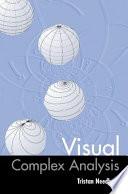
Now available in paperback, this successful radical approach to complex analysis replaces the standard calculational arguments with new geometric ones. With several hundred diagrams, and far fewer prerequisites than usual, this is the first visual intuitive introduction to complex analysis. Although designed for use by undergraduates in mathematics and science, the novelty of the approach will also interest professional mathematicians.
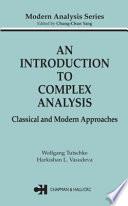
Like real analysis, complex analysis has generated methods indispensable to mathematics and its applications. Exploring the interactions between these two branches, this book uses the results of real analysis to lay the foundations of complex analysis and presents a unified structure of mathematical analysis as a whole. To set the groundwork and mitigate the difficulties newcomers often experience, An Introduction to Complex Analysis begins with a complete review of concepts and methods from real analysis, such as metric spaces and the Green-Gauss Integral Formula. The approach leads to brief, clear proofs of basic statements - a distinct advantage for those mainly interested in applications. Alternate approaches, such as Fichera's proof of the Goursat Theorem and Estermann's proof of the Cauchy's Integral Theorem, are also presented for comparison. Discussions include holomorphic functions, the Weierstrass Convergence Theorem, analytic continuation, isolated singularities, homotopy, Residue theory, conformal mappings, special functions and boundary value problems. More than 200 examples and 150 exercises illustrate the subject matter and make this book an ideal text for...
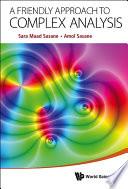
The book constitutes a basic, concise, yet rigorous course in complex analysis, for students who have studied calculus in one and several variables, but have not previously been exposed to complex analysis. The textbook should be particularly useful and relevant for undergraduate students in joint programmes with mathematics, as well as engineering students. The aim of the book is to cover the bare bones of the subject with minimal prerequisites. The core content of the book is the three main pillars of complex analysis: the Cauchy-Riemann equations, the Cauchy Integral Theorem, and Taylor and Laurent series expansions.Each section contains several problems, which are not purely drill exercises, but are rather meant to reinforce the fundamental concepts. Detailed solutions to all the exercises appear at the end of the book, making the book ideal also for self-study. There are many figures illustrating the text.
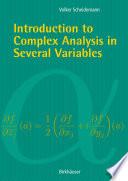
This book provides a comprehensive introduction to complex analysis in several variables. One major focus of the book is extension phenomena alien to the one-dimensional theory (Hartog's Kugelsatz, theorem of Cartan-Thullen, Bochner's theorem). The book primarily aims at students starting to work in the field of complex analysis in several variables and teachers who want to prepare a university lecture. Therefore, the book contains more than 50 examples and more than 100 supporting exercises.
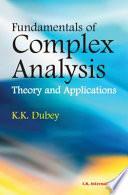
The book divided in ten chapters deals with: " Algebra of complex numbers and its various geometrical properties, properties of polar form of complex numbers and regions in the complex plane. " Limit, continuity, differentiability. " Different kinds of complex valued functions. " Different types of transformations. " Conformal mappings of different functions. " Properties of bilinear and special bilinear transformation. " Line integrals, their properties and different theorems. " Sequences and series, Power series, Zero s of functions, residues and residue theorem, meromorphic functions, different kinds of singularities. " Evaluation of real integrals. " Analytic continuation, construction of harmonic functions, infinite product, their properties and Gamma function. " Schwarz-Christoffel transformations, mapping by multi valued functions, entire functions. " Jenson s theorem and Poisson-Jenson theorem. The book is designed as a textbook for UG and PG students of science as well as engineering
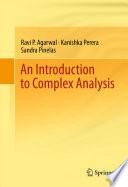
This textbook introduces the subject of complex analysis to advanced undergraduate and graduate students in a clear and concise manner. Key features of this textbook: effectively organizes the subject into easily manageable sections in the form of 50 class-tested lectures, uses detailed examples to drive the presentation, includes numerous exercise sets that encourage pursuing extensions of the material, each with an “Answers or Hints” section, covers an array of advanced topics which allow for flexibility in developing the subject beyond the basics, provides a concise history of complex numbers. An Introduction to Complex Analysis will be valuable to students in mathematics, engineering and other applied sciences. Prerequisites include a course in calculus.
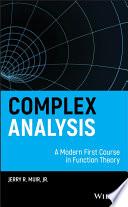
A thorough introduction to the theory of complex functions emphasizing the beauty, power, and counterintuitive nature of the subject Written with a reader-friendly approach, Complex Analysis: A Modern First Course in Function Theory features a self-contained, concise development of the fundamental principles of complex analysis. After laying groundwork on complex numbers and the calculus and geometric mapping properties of functions of a complex variable, the author uses power series as a unifying theme to define and study the many rich and occasionally surprising properties of analytic functions, including the Cauchy theory and residue theorem. The book concludes with a treatment of harmonic functions and an epilogue on the Riemann mapping theorem. Thoroughly classroom tested at multiple universities, Complex Analysis: A Modern First Course in Function Theory features: Plentiful exercises, both computational and theoretical, of varying levels of difficulty, including several that could be used for student projects Numerous figures to illustrate geometric concepts and constructions used in proofs Remarks at the conclusion of each section that place the main concepts in context,...
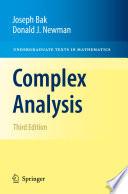
This unusual and lively textbook offers a clear and intuitive approach to the classical and beautiful theory of complex variables. With very little dependence on advanced concepts from several-variable calculus and topology, the text focuses on the authentic complex-variable ideas and techniques. Accessible to students at their early stages of mathematical study, this full first year course in complex analysis offers new and interesting motivations for classical results and introduces related topics stressing motivation and technique. Numerous illustrations, examples, and now 300 exercises, enrich the text. Students who master this textbook will emerge with an excellent grounding in complex analysis, and a solid understanding of its wide applicability.

All modem introductions to complex analysis follow, more or less explicitly, the pattern laid down in Whittaker and Watson [75]. In "part I'' we find the foundational material, the basic definitions and theorems. In "part II" we find the examples and applications. Slowly we begin to understand why we read part I. Historically this is an anachronism. Pedagogically it is a disaster. Part II in fact predates part I, so clearly it can be taught first. Why should the student have to wade through hundreds of pages before finding out what the subject is good for? In teaching complex analysis this way, we risk more than just boredom. Beginning with a series of unmotivated definitions gives a misleading impression of complex analy sis in particular and of mathematics in general. The classical theory of analytic functions did not arise from the idle speculation of bored mathematicians on the possible conse quences of an arbitrary set of definitions; it was the natural, even inevitable, consequence of the practical need to answer questions about specific examples. In standard texts, after hundreds of pages of theorems about generic analytic functions with only the rational and trigonometric...
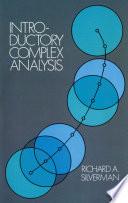
Shorter version of Markushevich's Theory of Functions of a Complex Variable, appropriate for advanced undergraduate and graduate courses in complex analysis. More than 300 problems, some with hints and answers. 1967 edition.
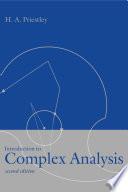
Complex analysis is a classic and central area of mathematics, which is studied and exploited in a range of important fields, from number theory to engineering. Introduction to Complex Analysis was first published in 1985, and for this much awaited second edition the text has been considerably expanded, while retaining the style of the original. More detailed presentation is given of elementary topics, to reflect the knowledge base of current students. Exercise sets have been substantially revised and enlarged, with carefully graded exercises at the end of each chapter. This is the latest addition to the growing list of Oxford undergraduate textbooks in mathematics, which includes: Biggs: Discrete Mathematics 2nd Edition, Cameron: Introduction to Algebra, Needham: Visual Complex Analysis, Kaye and Wilson: Linear Algebra, Acheson: Elementary Fluid Dynamics, Jordan and Smith: Nonlinear Ordinary Differential Equations, Smith: Numerical Solution of Partial Differential Equations, Wilson: Graphs, Colourings and the Four-Colour Theorem, Bishop: Neural Networks for Pattern Recognition, Gelman and Nolan: Teaching Statistics.
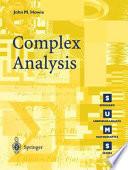
Complex analysis is one of the most attractive of all the core topics in an undergraduate mathematics course. Its importance to applications means that it can be studied both from a very pure perspective and a very applied perspective. This book takes account of these varying needs and backgrounds and provides a self-study text for students in mathematics, science and engineering. Beginning with a summary of what the student needs to know at the outset, it covers all the topics likely to feature in a first course in the subject, including: complex numbers, differentiation, integration, Cauchy's theorem, and its consequences, Laurent series and the residue theorem, applications of contour integration, conformal mappings, and harmonic functions. A brief final chapter explains the Riemann hypothesis, the most celebrated of all the unsolved problems in mathematics, and ends with a short descriptive account of iteration, Julia sets and the Mandelbrot set. Clear and careful explanations are backed up with worked examples and more than 100 exercises, for which full solutions are provided.

This book is an in-depth and modern presentation of important classical results in complex analysis and is suitable for a first course on the topic, as taught by the authors at several universities. The level of difficulty of the material increases gradually from chapter to chapter, and each chapter contains many exercises with solutions and applications of the results, with the particular goal of showcasing a variety of solution techniques.
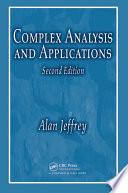
Complex Analysis and Applications, Second Edition explains complex analysis for students of applied mathematics and engineering. Restructured and completely revised, this textbook first develops the theory of complex analysis, and then examines its geometrical interpretation and application to Dirichlet and Neumann boundary value problems. “/p>
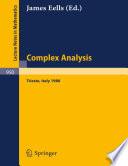
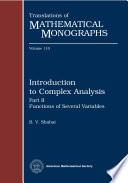
Since the 1960s, there has been a flowering in higher-dimensional complex analysis. Both classical and new results in this area have found numerous applications in analysis, differential and algebraic geometry, and, in particular, contemporary mathematical physics. In many areas of modern mathematics, the mastery of the foundations of higher-dimensional complex analysis has become necessary for any specialist. Intended as a first study of higher-dimensional complex analysis, this book covers the theory of holomorphic functions of several complex variables, holomorphic mappings, and submanifolds of complex Euclidean space.
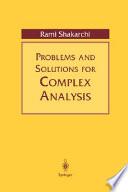
All the exercises plus their solutions for Serge Lang's fourth edition of "Complex Analysis," ISBN 0-387-98592-1. The problems in the first 8 chapters are suitable for an introductory course at undergraduate level and cover power series, Cauchy's theorem, Laurent series, singularities and meromorphic functions, the calculus of residues, conformal mappings, and harmonic functions. The material in the remaining 8 chapters is more advanced, with problems on Schwartz reflection, analytic continuation, Jensen's formula, the Phragmen-Lindeloef theorem, entire functions, Weierstrass products and meromorphic functions, the Gamma function and Zeta function. Also beneficial for anyone interested in learning complex analysis.
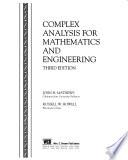
This text provides a balance between pure (theoretical) and applied aspects of complex analysis. The many applications of complex analysis to science and engineering are described, and this third edition contains a historical introduction depicting the origins of complex numbers.
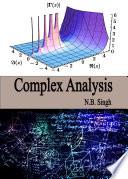
Complex Analysis is an introductory textbook designed for absolute beginners, offering a clear and straightforward exploration of complex numbers and functions. The book presents fundamental concepts in a step-by-step manner, making complex analysis accessible to those with little or no prior mathematical knowledge. Through practical examples and intuitive explanations, readers will discover the beauty of complex functions, the significance of Cauchy's integral formula, and the application of power series. Ideal for students and curious learners alike, this book serves as a solid foundation for further studies in mathematics.
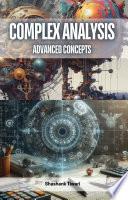
"Complex Analysis: Advanced Concepts" delves into the intricate world of complex numbers and functions, offering a thorough exploration of their properties and applications. The book begins with a detailed examination of basic concepts, covering arithmetic operations, geometric interpretations, and the fundamental theorem of algebra. It then progresses to advanced topics such as complex functions, differentiation, integration, and series. One of the book's notable strengths lies in its clear and concise explanations, accompanied by numerous examples and exercises to reinforce understanding. Readers are guided through theorems and proofs, gaining insight into the elegance and power of complex analysis. The book also highlights the relevance of complex analysis in various fields, including physics, engineering, and economics. Applications such as potential theory, fluid dynamics, and signal processing are explored, demonstrating the subject's practical significance. Whether used as a textbook for students or a reference for professionals, "Complex Analysis: Advanced Concepts" offers a valuable resource for mastering the intricacies of this essential branch of mathematics. Its...

This is an advanced text for the one- or two-semester course in analysis taught primarily to math, science, computer science, and electrical engineering majors at the junior, senior or graduate level. The basic techniques and theorems of analysis are presented in such a way that the intimate connections between its various branches are strongly emphasized. The traditionally separate subjects of 'real analysis' and 'complex analysis' are thus united in one volume. Some of the basic ideas from functional analysis are also included. This is the only book to take this unique approach. The third edition includes a new chapter on differentiation. Proofs of theorems presented in the book are concise and complete and many challenging exercises appear at the end of each chapter. The book is arranged so that each chapter builds upon the other, giving students a gradual understanding of the subject. This text is part of the Walter Rudin Student Series in Advanced Mathematics.
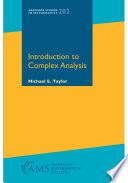
In this text, the reader will learn that all the basic functions that arise in calculus—such as powers and fractional powers, exponentials and logs, trigonometric functions and their inverses, as well as many new functions that the reader will meet—are naturally defined for complex arguments. Furthermore, this expanded setting leads to a much richer understanding of such functions than one could glean by merely considering them in the real domain. For example, understanding the exponential function in the complex domain via its differential equation provides a clean path to Euler's formula and hence to a self-contained treatment of the trigonometric functions. Complex analysis, developed in partnership with Fourier analysis, differential equations, and geometrical techniques, leads to the development of a cornucopia of functions of use in number theory, wave motion, conformal mapping, and other mathematical phenomena, which the reader can learn about from material presented here. This book could serve for either a one-semester course or a two-semester course in complex analysis for beginning graduate students or for well-prepared undergraduates whose background includes...
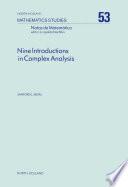
Nine Introductions in Complex Analysis
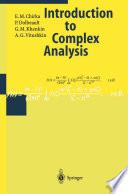
From the reviews: "... In sum, the volume under review is the first quarter of an important work that surveys an active branch of modern mathematics. Some of the individual articles are reminiscent in style of the early volumes of the first Ergebnisse series and will probably prove to be equally useful as a reference; ...for the appropriate reader, they will be valuable sources of information about modern complex analysis." Bulletin of the Am.Math.Society, 1991 "... This remarkable book has a helpfully informal style, abundant motivation, outlined proofs followed by precise references, and an extensive bibliography; it will be an invaluable reference and a companion to modern courses on several complex variables." ZAMP, Zeitschrift für Angewandte Mathematik und Physik, 1990
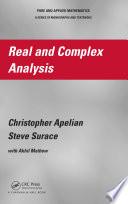
Presents Real & Complex Analysis Together Using a Unified ApproachA two-semester course in analysis at the advanced undergraduate or first-year graduate levelUnlike other undergraduate-level texts, Real and Complex Analysis develops both the real and complex theory together. It takes a unified, elegant approach to the theory that is consistent with
Opciones de Descarga